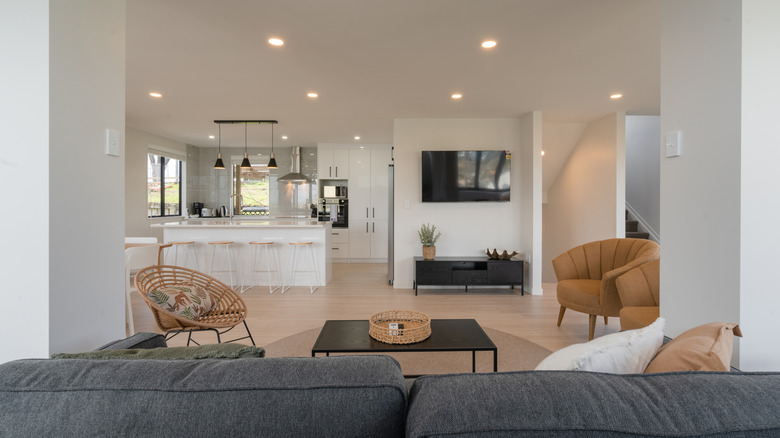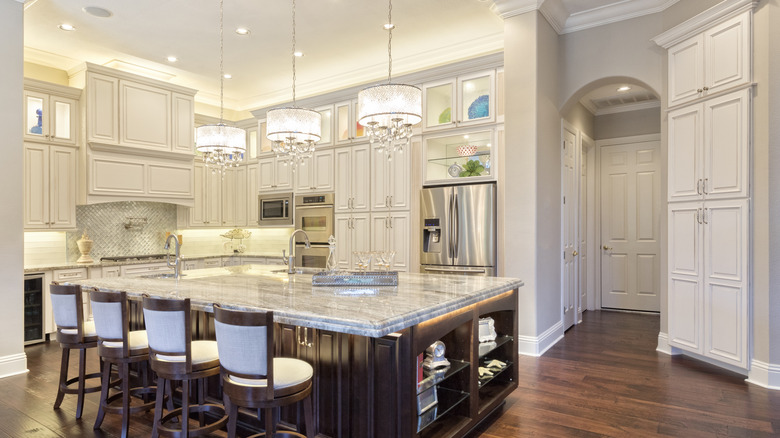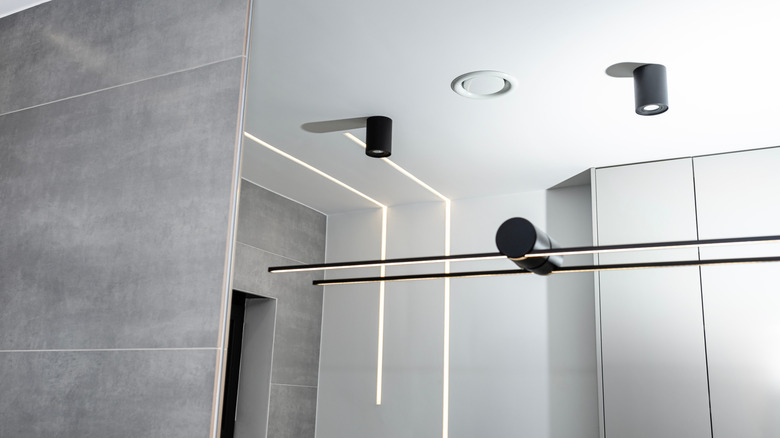Are Recessed Lights Still A Good Idea, Or Are They Outdated?
If you're on the market for a new house or thinking about making some upgrades to your current home, you may be wondering whether recessed lighting is still a good idea. These fixtures, which are also called canned lights, are installed to be flush (or recessed) with the ceiling, providing overhead lighting to illuminate a space. However, they've been around for decades, so it's natural to wonder whether they have a place in modern design trends.
To help us learn more about this topic, we reached out to Dara Greaney, an expert in light design and lighting fixtures and the founder and CEO of LED Light Expert. "It's hard to beat the lighting performance [of recessed fixtures] in terms of coverage and uniformity in spaces like kitchens and family rooms with any other lighting product," Greaney said while exclusively with House Digest. So, it doesn't look like recessed fixtures are going anywhere any time soon. Ahead, we'll take a look at some more of the reasons can lights are perfect for your home. We'll also share some of Greaney's insights on current lighting trends and what that may mean for recessed lighting.
Recessed lighting is likely here to stay
We asked Dara Greaney whether recessed lights were outdated, or if they are still a good choice when designing a space. "They still make for the best 'house lights,'" Greaney exclusively told House Digest, adding "We're fans of them in a lot of rooms including kitchen, family, bathrooms, garages and even bedrooms." There's a lot to love about recessed lighting. You can customize the amount of lighting for each space based on where you position the cans in the ceiling. And, because the lighting comes from overhead, it can do a better job of illuminating an entire space. Plus, as Greaney shares, "The big pro is great lighting that takes up zero space. From a functional standpoint, it can't be beat."
However, while Greaney believes recessed lighting can be an asset in a home, he does note that there are some downsides that you'll also need to consider and compensate for in other ways. "They certainly don't bring any architectural interest or style into a space, we recommend adding specialty fixtures to do that. Pendants in the kitchen are great, floor and table lamps can be added anywhere and surface mount ceiling lights, such as panels, are popular ways to add the style you want." When you're looking for the best type of lighting to use in your kitchen and other rooms, consider a layered approach. Recessed fixtures to deliver ambient lighting to illuminate the whole room, table and desk lamps, under-cabinet lights for task lighting, and wall sconces for accent lighting.
What changing trends could mean for home lighting
While Dara Greaney still considers recessed lighting to be in style, he does acknowledge that the fixtures may evolve to better match current design trends and preferences. "We are seeing some newer smaller versions coming out and we can see that as the future. Instead of 4 or 6 inch across that mimicked the old par style bulbs, you could do it in 2 to 3 inch space for a sleeker more modern look," he exclusively told House Digest in an interview. Another potential recessed lighting change that Greaney says is possible is a shift to much bigger recessed light fixtures. He highlights blue sky panels as a potential evolution for the in-ceiling fixtures.
As functional and stylish as they are, recessed lights may not be for everyone. "The con is they are now 30 years old and everyone wants newer, fresher ideas," Greaney explained. Beyond the potential changes to the recessed fixtures that he shared above, he also notes that designers and consumers are exploring other options. "Other than things like RGB and strip lighting, accenting wall or ceiling features can be done. Panel lights can be an option," he shared. If you're planning a full renovation or building a new house, there may be one more alternative to using LED light strips to brighten up your home. "Newer houses are using rope or strip lighting to create different effects, but that has to be designed into the building from the get go," Greaney noted. These upgrades would be too involved to incorporate into an existing structure, unless all the walls and ceilings are coming down.


